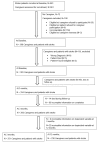Dyadic approach to supervised community rehabilitation participation in an Asian setting post-stroke: exploring the role of caregiver and patient characteristics in a prospective cohort study
- PMID: 32332008
- PMCID: PMC7204848
- DOI: 10.1136/bmjopen-2019-036631
Dyadic approach to supervised community rehabilitation participation in an Asian setting post-stroke: exploring the role of caregiver and patient characteristics in a prospective cohort study
Abstract
Objective: To study the association of caregiver factors and stroke survivor factors with supervised community rehabilitation (SCR) participation over the first 3 months and subsequent 3 to 12 months post-stroke in an Asian setting.
Design: Prospective cohort study.
Setting: Community setting.
Participants: We recruited stroke survivors and their caregivers into our yearlong cohort. Caregiver and stroke survivor variables were collected over 3-monthly intervals. We performed logistic regression with the outcome variable being SCR participation post-stroke.
Outcome measures: SCR participation over the first 3 months and subsequent 3 to 12 months post-stroke RESULTS: 251 stroke survivor-caregiver dyads were available for the current analysis. The mean age of caregivers was 50.1 years, with the majority being female, married and co-residing with the stroke survivor. There were 61%, 28%, 4% and 7% of spousal, adult-child, sibling and other caregivers. The odds of SCR participation decreased by about 15% for every unit increase in caregiver-reported stroke survivor's disruptive behaviour score (OR: 0.845; 95% CI: 0.769 to 0.929). For every 1-unit increase in the caregiver's positive management strategy score, the odds of using SCR service increased by about 4% (OR: 1.039; 95% CI: 1.011 to 1.068).
Conclusion: We established that SCR participation is jointly determined by both caregiver and stroke survivor factors, with factors varying over the early and late post-stroke period. Our results support the adoption of a dyadic or more inclusive approach for studying the utilisation of community rehabilitation services, giving due consideration to both the stroke survivors and their caregivers. Adopting a stroke survivor-caregiver dyadic approach in practice settings should include promotion of positive care management strategies, comprehensive caregiving training including both physical and behavioural dimensions, active engagement of caregivers in rehabilitation journey and conducting regular caregiver needs assessments in the community.
Keywords: organisation of health services; public health; rehabilitation medicine; social medicine; stroke.
© Author(s) (or their employer(s)) 2020. Re-use permitted under CC BY-NC. No commercial re-use. See rights and permissions. Published by BMJ.
Conflict of interest statement
Competing interests: None declared.
Similar articles
-
Roles of Changing Physical Function and Caregiver Burden on Quality of Life in Stroke: A Longitudinal Dyadic Analysis.Stroke. 2017 Mar;48(3):733-739. doi: 10.1161/STROKEAHA.116.014989. Epub 2017 Feb 14. Stroke. 2017. PMID: 28196939
-
The effects of a family-focused dyadic psychoeducational intervention for stroke survivors and their family caregivers: A randomised controlled trial.Int J Nurs Stud. 2023 Jul;143:104504. doi: 10.1016/j.ijnurstu.2023.104504. Epub 2023 Apr 17. Int J Nurs Stud. 2023. PMID: 37149953 Clinical Trial.
-
Effectiveness of a strength-oriented psychoeducation on caregiving competence, problem-solving abilities, psychosocial outcomes and physical health among family caregiver of stroke survivors: A randomised controlled trial.Int J Nurs Stud. 2018 Nov;87:84-93. doi: 10.1016/j.ijnurstu.2018.07.005. Epub 2018 Jul 28. Int J Nurs Stud. 2018. PMID: 30059815 Clinical Trial.
-
Effectiveness of dyadic interventions to improve stroke patient-caregiver dyads' outcomes after discharge: A systematic review and meta-analysis study.Eur J Cardiovasc Nurs. 2021 Jan 1;20(1):14-33. doi: 10.1177/1474515120926069. Eur J Cardiovasc Nurs. 2021. PMID: 33570593
-
[Caregiver burden in relatives of persons with schizophrenia: an overview of measure instruments].Encephale. 2003 Mar-Apr;29(2):137-47. Encephale. 2003. PMID: 14567165 Review. French.
Cited by
-
Burden of informal care in stroke survivors and its determinants: a prospective observational study in an Asian setting.BMC Public Health. 2021 Oct 26;21(1):1945. doi: 10.1186/s12889-021-11991-3. BMC Public Health. 2021. PMID: 34702247 Free PMC article.
-
The associations between caregivers' psychosocial characteristics and caregivers' depressive symptoms in stroke settings: a cohort study.BMC Psychol. 2022 May 9;10(1):121. doi: 10.1186/s40359-022-00828-2. BMC Psychol. 2022. PMID: 35534900 Free PMC article.
-
The effect of tailored nursing interventions based on the IKAP model on the discharge readiness of the spouses or children of breast cancer patients: a randomized controlled trial.Support Care Cancer. 2025 Aug 8;33(9):765. doi: 10.1007/s00520-025-09819-6. Support Care Cancer. 2025. PMID: 40779181 Free PMC article. Clinical Trial.
-
Examining the Influence of Social Interactions and Community Resources on Caregivers' Burden in Stroke Settings: A Prospective Cohort Study.Int J Environ Res Public Health. 2021 Nov 23;18(23):12310. doi: 10.3390/ijerph182312310. Int J Environ Res Public Health. 2021. PMID: 34886031 Free PMC article.
-
Role of caregiver factors in outpatient medical follow-up post-stroke: observational study in Singapore.BMC Fam Pract. 2021 Apr 14;22(1):74. doi: 10.1186/s12875-021-01405-z. BMC Fam Pract. 2021. PMID: 33853544 Free PMC article.
References
-
- Registry SS. Trends in stroke in Singapore 2005-2012. Singapore: National Registry of Diseases Office, Ministry of Health.
Publication types
MeSH terms
LinkOut - more resources
Full Text Sources
Medical

